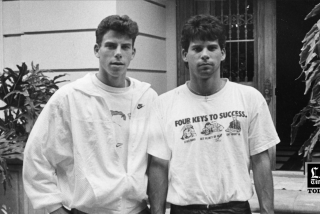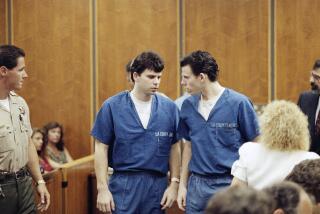New DNA Tests Force Review of ’92 Murder Case
A judge has taken the unusual step of ordering a fresh look at a 1992 Yorba Linda murder case after new DNA tests raised questions about the evidence used to convict a Brea man for the killing.
Prosecutors relied largely on DNA evidence at the 1994 trial of Michael Kevin Claude, but a new batch of testing, performed at the request of prosecutors and Claude’s lawyers, appears to contradict some key components of the case, according to court records.
“The court finds the newly discovered evidence to be material and central to the issue of the reliability of the DNA evidence upon which the people relied to prove their case,” Judge Daniel J. Didier wrote in an order issued last Friday.
Didier asked prosecutors to file a written response to the new evidence. He tentatively scheduled a September hearing to decide whether to overturn Claude’s conviction and award him a new trial.
The reopening of Claude’s case marks the latest of several convictions won by Orange County prosecutors that have unraveled or are now under review.
In January, an Orange County judge ordered the release of DeWayne McKinney after prosecutors concluded he spent more than 19 years in prison for a murder likely committed by another man. Last year, the 4th District Court of Appeal in Santa Ana reversed the murder convictions of two women whose children were found dead shortly after birth. The same court also ordered a judge to conduct a hearing to determine whether Costa Mesa teenager Arthur Carmona should be given a new trial after his supporters alleged his robbery conviction was based on mistaken witness testimony.
The new questions about Claude’s conviction comes eight years after police found the nude body of 19-year-old Nancy Elsayed on the front seat of her friend’s red Datsun sedan parked on an embankment near Auto Plaza Circle. A dress was draped over her body. She’d been shot eight times.
Claude was arrested several months later, after DNA testing linked him to semen found in the victim’s body. The DNA evidence and physical evidence in the Datsun led the prosecution to argue that Claude had sex with Elsayed in the car before shooting her to death.
Claude’s lawyer contended that the semen was left over from a sexual encounter the previous day. But prosecutor Patrick Donahue told the jury that the defense theory did not make sense because no semen was found in Elsayed’s underwear.
“That’s why we have DNA, to put together cases like this. That’s what it’s all for,” Donahue argued to the jury, according to trial transcripts.
Now Claude is using a more sophisticated type of DNA testing to assert his innocence. Scientific analysis completed this year shows Claude’s semen was in fact on the victim’s underwear--evidence, his lawyer contends, that Claude and the victim had sex elsewhere before she was killed.
The testing also found the semen of another man on the victim’s body, according to court records.
“The new evidence squarely contradicts the most important evidence presented at trial,” said Claude’s lawyer, Douglas J. Myers. “The jury reached a verdict based on a completely false understanding of the evidence.”
During the trial, prosecutors argued that the defendant had a clear motive to kill Elsayed. In the days before her death, Elsayed told police about Claude’s involvement in another crime. She told a friend she planned to spend the day before her death with “Mikey.” She and Claude had a past relationship, according to testimony.
Donahue said this week that he prosecuted Claude because he believed the evidence proved he was guilty.
Donahue, who told the jury only Claude’s sperm was found in the victim, said he was not surprised by the discovery of another man’s genetic material. Witnesses testified that Elsayed had sex with another man in the days before she died, he said.
The prosecutor would not say whether he thought Claude’s conviction should stand.
“I convicted the guy, and I thought Michael Claude killed the girl,” Donahue said. “I don’t want to answer the question, ‘Is he entitled to a new trial?’ That’s what the hearing is for. Just because there’s new evidence doesn’t necessarily mean there’s a new trial.”
Claude, 28, is serving a sentence of 30 years to life in prison at the California Correctional Institution in Tehachapi. The pending September hearing will mark a legal milestone for Claude, whose five-year battle for a new trial has woven between the 4th District Court of Appeal and the Orange County Superior Court in Santa Ana. Shortly after his conviction, Claude’s family paid a lab to retest some of the DNA evidence.
Myers said he believes the evidence is now on Claude’s side. He will argue for a new trial based on the new DNA analysis and the allegation that Claude’s trial lawyer inadequately defended him. The more sensitive DNA procedure used to discover the new evidence was available at the time of trial, but his attorney did not ask scientists to utilize it, Myers said.
“It’s clear he should get a new trial,” Myers said this week at his Santa Ana office.
More to Read
Sign up for Essential California
The most important California stories and recommendations in your inbox every morning.
You may occasionally receive promotional content from the Los Angeles Times.











